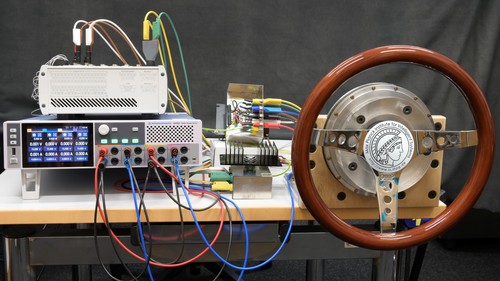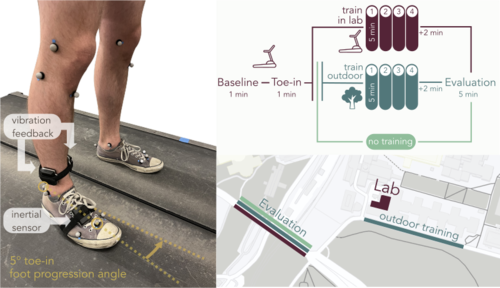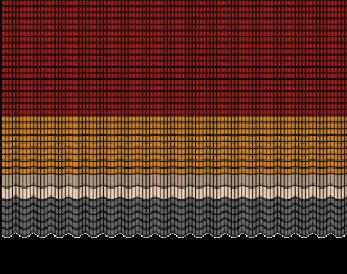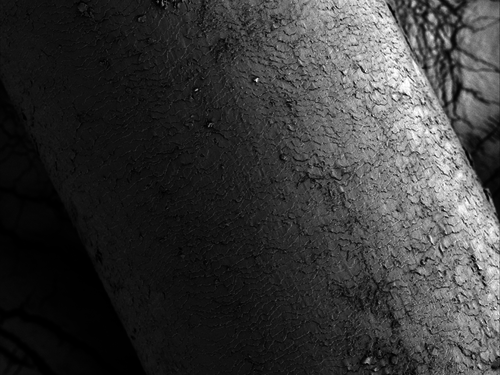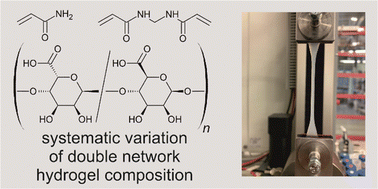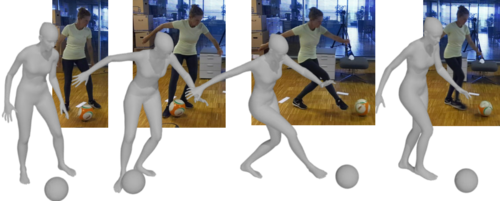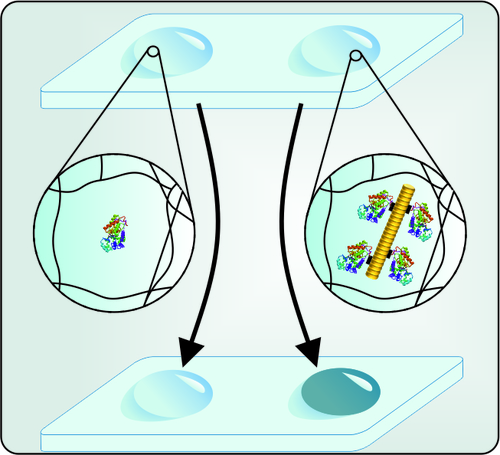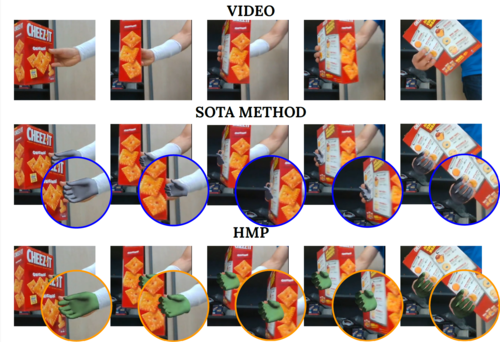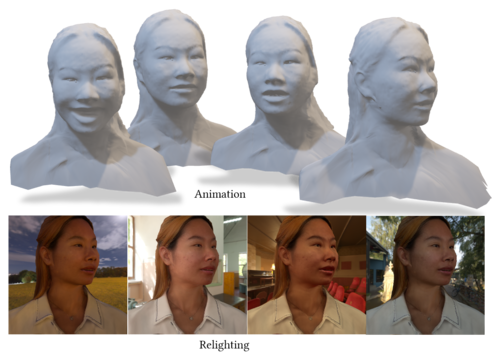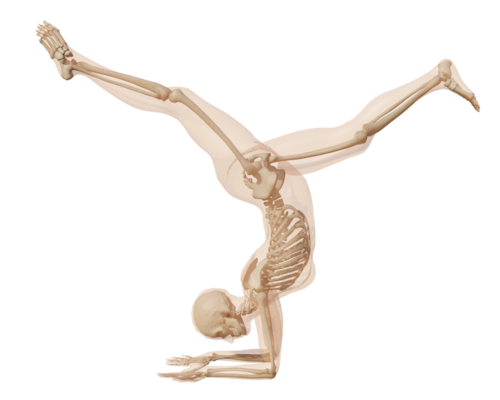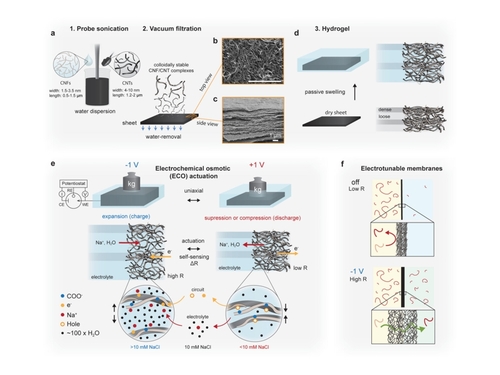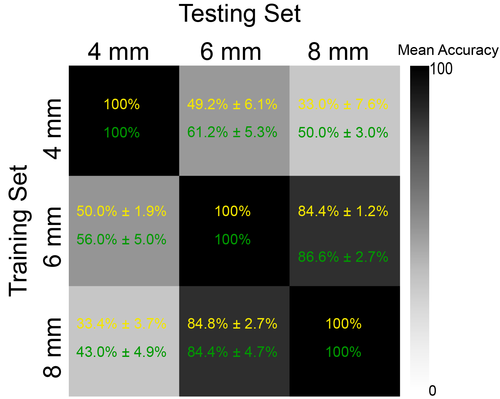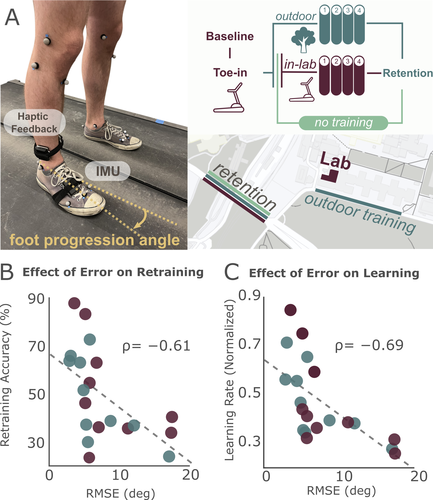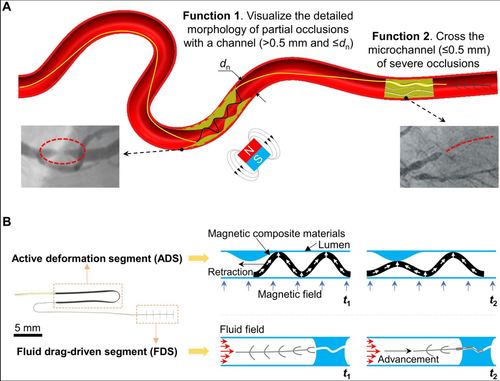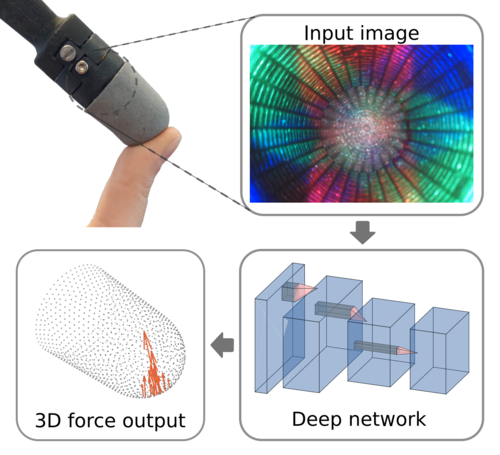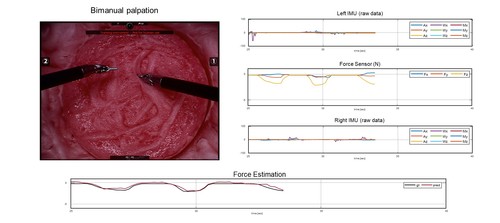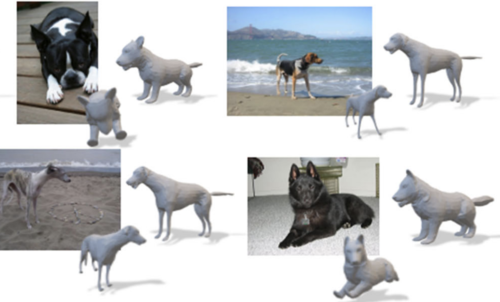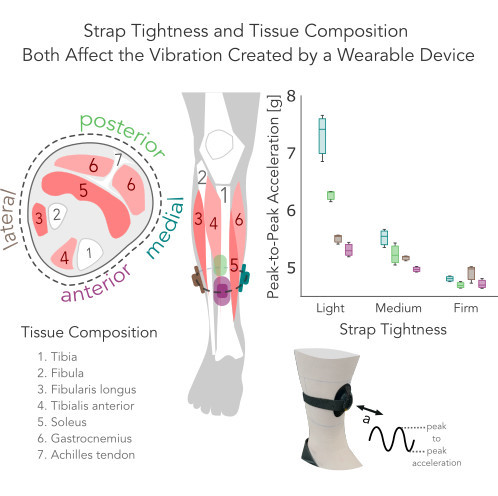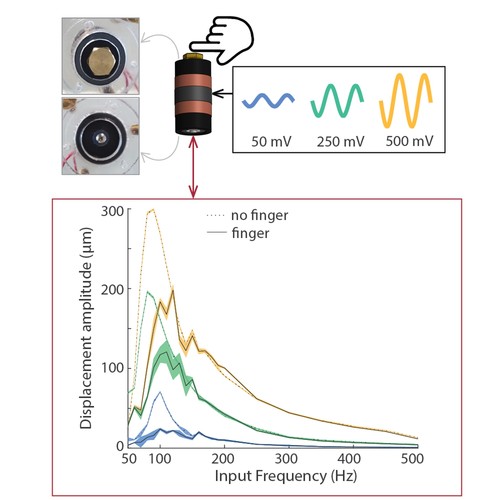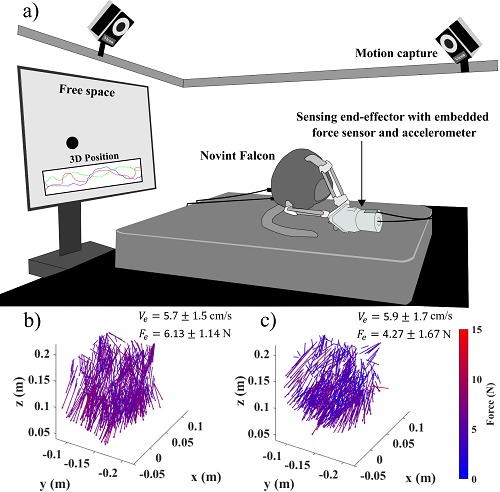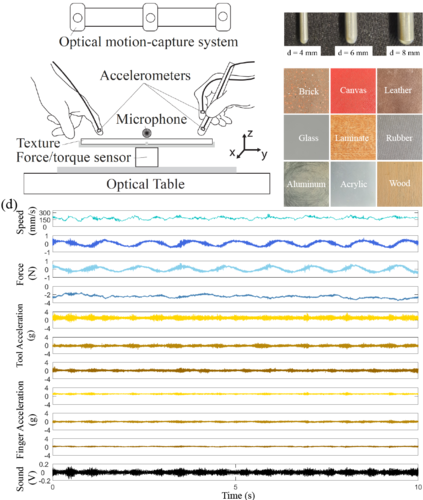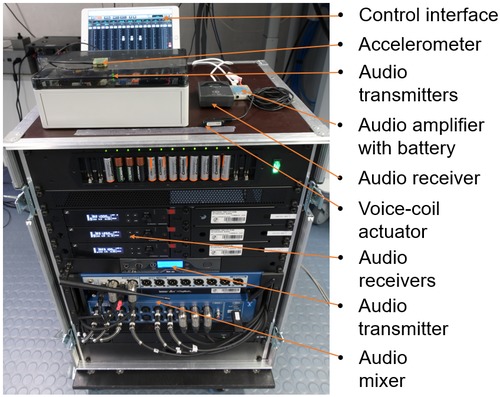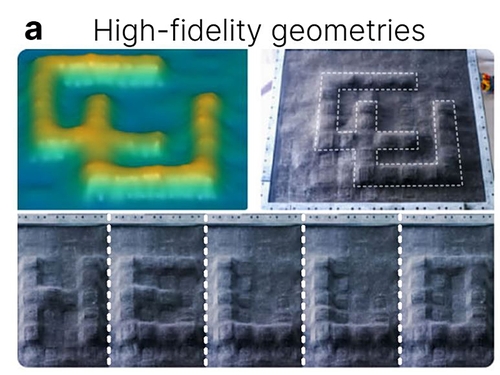2024
hi
Rokhmanova, N., Martus, J., Faulkner, R., Fiene, J., Kuchenbecker, K. J.
GaitGuide: A Wearable Device for Vibrotactile Motion Guidance
Workshop paper (3 pages) presented at the ICRA Workshop on Advancing Wearable Devices and Applications Through Novel Design, Sensing, Actuation, and AI, Yokohama, Japan, May 2024 (misc) Accepted
hi
Javot, B., Nguyen, V. H., Ballardini, G., Kuchenbecker, K. J.
CAPT Motor: A Strong Direct-Drive Rotary Haptic Interface
Hands-on demonstration presented at the IEEE Haptics Symposium, Long Beach, USA, April 2024 (misc)
hi
rm
Sanchez-Tamayo, N., Yoder, Z., Ballardini, G., Rothemund, P., Keplinger, C., Kuchenbecker, K. J.
Cutaneous Electrohydraulic (CUTE) Wearable Devices for Multimodal Haptic Feedback
Extended abstract (1 page) presented at the IEEE RoboSoft Workshop on Multimodal Soft Robots for Multifunctional Manipulation, Locomotion, and Human-Machine Interaction, San Diego, USA, April 2024 (misc)
hi
Fazlollahi, F., Seifi, H., Ballardini, G., Taghizadeh, Z., Schulz, A., MacLean, K. E., Kuchenbecker, K. J.
Quantifying Haptic Quality: External Measurements Match Expert Assessments of Stiffness Rendering Across Devices
Work-in-progress paper (2 pages) presented at the IEEE Haptics Symposium, Long Beach, USA, April 2024 (misc)
hi
rm
Sanchez-Tamayo, N., Yoder, Z., Ballardini, G., Rothemund, P., Keplinger, C., Kuchenbecker, K. J.
Cutaneous Electrohydraulic Wearable Devices for Expressive and Salient Haptic Feedback
Hands-on demonstration presented at the IEEE Haptics Symposium, Long Beach, USA, April 2024 (misc)
hi
Serhat, G., Kuchenbecker, K. J.
Fingertip Dynamic Response Simulated Across Excitation Points and Frequencies
Biomechanics and Modeling in Mechanobiology, April 2024 (article) Accepted
hi
rm
Sanchez-Tamayo, N., Yoder, Z., Ballardini, G., Rothemund, P., Keplinger, C., Kuchenbecker, K. J.
Demonstration: Cutaneous Electrohydraulic (CUTE) Wearable Devices for Expressive and Salient Haptic Feedback
Hands-on demonstration presented at the IEEE RoboSoft Conference, San Diego, USA, April 2024 (misc)
hi
Rokhmanova, N., Pearl, O., Kuchenbecker, K. J., Halilaj, E.
IMU-Based Kinematics Estimation Accuracy Affects Gait Retraining Using Vibrotactile Cues
IEEE Transactions on Neural Systems and Rehabilitation Engineering, 32, pages: 1005-1012, February 2024 (article)
hi
Schulz, A., Serhat, G., Kuchenbecker, K. J.
Adapting a High-Fidelity Simulation of Human Skin for Comparative Touch Sensing in the Elephant Trunk
Abstract presented at the Society for Integrative and Comparative Biology Annual Meeting (SICB), Seattle, USA, January 2024 (misc)
hi
Khojasteh, B., Shao, Y., Kuchenbecker, K. J.
MPI-10: Haptic-Auditory Measurements from Tool-Surface Interactions
Dataset published as a companion to the journal article "Robust Surface Recognition with the Maximum Mean Discrepancy: Degrading Haptic-Auditory Signals through Bandwidth and Noise" in IEEE Transactions on Haptics, January 2024 (misc)
hi
Fitter, N. T., Mohan, M., Preston, R. C., Johnson, M. J., Kuchenbecker, K. J.
How Should Robots Exercise with People? Robot-Mediated Exergames Win with Music, Social Analogues, and Gameplay Clarity
Frontiers in Robotics and AI, 10(1155837):1-18, January 2024 (article)
zwe-csfm
hi
Schulz, A., Kaufmann, L., Brecht, M., Richter, G., Kuchenbecker, K. J.
Whiskers That Don’t Whisk: Unique Structure From the Absence of Actuation in Elephant Whiskers
Abstract presented at the Society for Integrative and Comparative Biology Annual Meeting (SICB), Seattle, USA, January 2024 (misc)
hi
Khojasteh, B., Shao, Y., Kuchenbecker, K. J.
Robust Surface Recognition with the Maximum Mean Discrepancy: Degrading Haptic-Auditory Signals through Bandwidth and Noise
IEEE Transactions on Haptics, 17(1):58-65, January 2024, Presented at the IEEE Haptics Symposium (article)
zwe-csfm
Gorke, O., Stuhlmüller, M., Tovar, G. E. M., Southan, A.
Unravelling parameter interactions in calcium alginate/polyacrylamide double network hydrogels using a design of experiments approach for the optimization of mechanical properties
Materials Advances, 5, pages: 2851-2859, Royal Society of Chemistry, 2024 (article)
ps
Huang, Y., Taheri, O., Black, M. J., Tzionas, D.
InterCap: Joint Markerless 3D Tracking of Humans and Objects in Interaction from Multi-view RGB-D Images
International Journal of Computer Vision (IJCV), 2024 (article)
al
Simon, A., Weimar, J., Martius, G., Oettel, M.
Machine learning of a density functional for anisotropic patchy particles
Journal of Chemical Theory and Computation, 2024 (article)
zwe-csfm
Grübel, J., Wendlandt, T., Urban, D., Jauch, C. O., Wege, C., Tovar, G. E. M., Southan, A.
Soft Sub-Structured Multi-Material Biosensor Hydrogels with Enzymes Retained by Plant Viral Scaffolds
Macromolecular Bioscience, 24(3):2300311, Wiley, 2024 (article)
ev
Xue, Y., Li, H., Leutenegger, S., Stueckler, J.
Event-based Non-Rigid Reconstruction of Low-Rank Parametrized Deformations from Contours
International Journal of Computer Vision (IJCV), 2024 (article)
ei
Tsirtsis, S., Tabibian, B., Khajehnejad, M., Singla, A., Schölkopf, B., Gomez-Rodriguez, M.
Optimal Decision Making Under Strategic Behavior
Management Science, 2024, Published Online (article) In press
ps
Duran, E., Kocabas, M., Choutas, V., Fan, Z., Black, M. J.
HMP: Hand Motion Priors for Pose and Shape Estimation from Video
Proceedings of the IEEE/CVF Winter Conference on Applications of Computer Vision (WACV), 2024 (article)
hi
Landin, N., Romano, J. M., McMahan, W., Kuchenbecker, K. J.
Discrete Fourier Transform Three-to-One (DFT321): Code
MATLAB code of discrete fourier transform three-to-one (DFT321), 2024 (misc)
2023
pio
Ruggeri, N., Lonardi, A., De Bacco, C.
Message-Passing on Hypergraphs: Detectability, Phase Transitions and Higher-Order Information
December 2023 (article)
ps
Bharadwaj, S., Zheng, Y., Hilliges, O., Black, M. J., Abrevaya, V. F.
FLARE: Fast learning of Animatable and Relightable Mesh Avatars
ACM Transactions on Graphics, 42(6):204:1-204:15, December 2023 (article) Accepted
ps
Keller, M., Werling, K., Shin, S., Delp, S., Pujades, S., Liu, C. K., Black, M. J.
From Skin to Skeleton: Towards Biomechanically Accurate 3D Digital Humans
ACM Transaction on Graphics (ToG), 42(6):253:1-253:15, December 2023 (article)
hi
L’Orsa, R., Lama, S., Westwick, D., Sutherland, G., Kuchenbecker, K. J.
Towards Semi-Automated Pleural Cavity Access for Pneumothorax in Austere Environments
Acta Astronautica, 212, pages: 48-53, November 2023 (article)
pio
Badalyan, A., Ruggeri, N., De Bacco, C.
Hypergraphs with node attributes: structure and inference
November 2023 (article) Submitted
rm
Benselfelt, T., Shakya, J., Rothemund, P., Lindström, S. B., Piper, A., Winkler, T. E., Hajian, A., Wågberg, L., Keplinger, C., Hamedi, M. M.
Electrochemically Controlled Hydrogels with Electrotunable Permeability and Uniaxial Actuation
Advanced Materials, 35(45):2303255, Wiley-VCH GmbH, November 2023 (article)
hi
Khojasteh, B., Shao, Y., Kuchenbecker, K. J.
Seeking Causal, Invariant, Structures with Kernel Mean Embeddings in Haptic-Auditory Data from Tool-Surface Interaction
Workshop paper (4 pages) presented at the IROS Workshop on Causality for Robotics: Answering the Question of Why, Detroit, USA, October 2023 (misc)
ei
Hupkes, D., Giulianelli, M., Dankers, V., Artetxe, M., Elazar, Y., Pimentel, T., Christodoulopoulos, C., Lasri, K., Saphra, N., Sinclair, A., Ulmer, D., Schottmann, F., Batsuren, K., Sun, K., Sinha, K., Khalatbari, L., Ryskina, M., Frieske, R., Cotterell, R., Jin, Z.
A taxonomy and review of generalization research in NLP
Nature Machine Intelligence, 5(10):1161-1174, October 2023 (article)
hi
Allemang–Trivalle, A.
Enhancing Surgical Team Collaboration and Situation Awareness through Multimodal Sensing
Proceedings of the ACM International Conference on Multimodal Interaction (ICMI), pages: 716-720, Extended abstract (5 pages) presented at the ACM International Conference on Multimodal Interaction (ICMI) Doctoral Consortium, Paris, France, October 2023 (misc)
pio
Ibrahim, A. A., Muehlebach, M., De Bacco, C.
Optimal transport with constraints: from mirror descent to classical mechanics
September 2023 (article) Submitted
hi
Garrofé, G., Schoeffmann, C., Zangl, H., Kuchenbecker, K. J., Lee, H.
NearContact: Accurate Human Detection using Tomographic Proximity and Contact Sensing with Cross-Modal Attention
Extended abstract (4 pages) presented at the International Workshop on Human-Friendly Robotics (HFR), Munich, Germany, September 2023 (misc)
hi
Khojasteh, B., Solowjow, F., Trimpe, S., Kuchenbecker, K. J.
Multimodal Multi-User Surface Recognition with the Kernel Two-Sample Test
IEEE Transactions on Automation Science and Engineering, pages: 1-16, August 2023 (article)
ei
Hawkins-Hooker, A., Visonà, G., Narendra, T., Rojas-Carulla, M., Schölkopf, B., Schweikert, G.
Getting personal with epigenetics: towards individual-specific epigenomic imputation with machine learning
Nature Communications, 14(1), August 2023 (article)
hi
Rokhmanova, N., Pearl, O., Kuchenbecker, K. J., Halilaj, E.
The Role of Kinematics Estimation Accuracy in Learning with Wearable Haptics
Abstract presented at the American Society of Biomechanics (ASB), Knoxville, USA, August 2023 (misc)
pio
Della Vecchia, A., Neocosmos, K., Larremore, D. B., Moore, C., De Bacco, C.
A model for efficient dynamical ranking in networks
August 2023 (article) Submitted
al
hi
Andrussow, I., Sun, H., Kuchenbecker, K. J., Martius, G.
Minsight: A Fingertip-Sized Vision-Based Tactile Sensor for Robotic Manipulation
Advanced Intelligent Systems, 5(8):2300042, August 2023, Inside back cover (article)
hi
Lee, Y., Husin, H. M., Forte, M., Lee, S., Kuchenbecker, K. J.
Learning to Estimate Palpation Forces in Robotic Surgery From Visual-Inertial Data
IEEE Transactions on Medical Robotics and Bionics, 5(3):496-506, August 2023 (article)
ps
Rueegg, N., Zuffi, S., Schindler, K., Black, M. J.
BARC: Breed-Augmented Regression Using Classification for 3D Dog Reconstruction from Images
Int. J. of Comp. Vis. (IJCV), 131(8):1964–1979, August 2023 (article)
hi
Rokhmanova, N., Faulkner, R., Martus, J., Fiene, J., Kuchenbecker, K. J.
Strap Tightness and Tissue Composition Both Affect the Vibration Created by a Wearable Device
Work-in-progress paper (1 page) presented at the IEEE World Haptics Conference (WHC), Delft, The Netherlands, July 2023 (misc)
hi
Ballardini, G., Kuchenbecker, K. J.
Toward a Device for Reliable Evaluation of Vibrotactile Perception
Work-in-progress paper (1 page) presented at the IEEE World Haptics Conference (WHC), Delft, The Netherlands, July 2023 (misc)
hi
Khojasteh, B., Solowjow, F., Trimpe, S., Kuchenbecker, K. J.
Multimodal Multi-User Surface Recognition with the Kernel Two-Sample Test: Code
Code published as a companion to the journal article "Multimodal Multi-User Surface Recognition with the Kernel Two-Sample Test" in IEEE Transactions on Automation Science and Engineering, July 2023 (misc)
hi
Fazlollahi, F., Taghizadeh, Z., Kuchenbecker, K. J.
Improving Haptic Rendering Quality by Measuring and Compensating for Undesired Forces
Work-in-progress paper (1 page) presented at the IEEE World Haptics Conference (WHC), Delft, The Netherlands, July 2023 (misc)
hi
Khojasteh, B., Shao, Y., Kuchenbecker, K. J.
Capturing Rich Auditory-Haptic Contact Data for Surface Recognition
Work-in-progress paper (1 page) presented at the IEEE World Haptics Conference (WHC), Delft, The Netherlands, July 2023 (misc)
hi
Gong, Y., Javot, B., Lauer, A. P. R., Sawodny, O., Kuchenbecker, K. J.
AiroTouch: Naturalistic Vibrotactile Feedback for Telerobotic Construction
Hands-on demonstration presented at the IEEE World Haptics Conference, Delft, The Netherlands, July 2023 (misc)
ei
Ortiz-Jimenez*, G., de Jorge*, P., Sanyal, A., Bibi, A., Dokania, P. K., Frossard, P., Rogez, G., Torr, P.
Catastrophic overfitting can be induced with discriminative non-robust features
Transactions on Machine Learning Research , July 2023, *equal contribution (article)
pio
Lonardi, A., De Bacco, C.
Bilevel Optimization for Traffic Mitigation in Optimal Transport Networks
Physical Review Letter, July 2023 (article) Accepted
rm
Johnson, B. K., Naris, M., Sundaram, V., Volchko, A., Ly, K., Mitchell, S. K., Acome, E., Kellaris, N., Keplinger, C., Correll, N., Humbert, J. S., Rentschler, M. E.
A Multifunctional Soft Robotic Shape Display with High-speed Actuation, Sensing, and Control
Nature Communications, 14(1), July 2023 (article)


